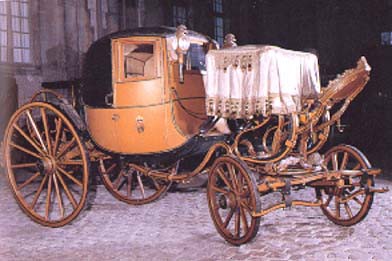Founded in 1927, on the initiative of the Touring Club de France, the French National Car and Tourism museum takes as its theme the history of road transport from its origins in horse-drawn vehicles to the beginnings of the motor car. Examples of two types of horse-drawn vehicle are on display, namely four-wheelers and two-wheelers.
The most notable items on show are: the berline used by Bonaparte for his entry into Bologna, 19 June, 1796; the travelling coupé belonging to général Maison; various First Empire coupés and barouches; and Ferdinand VII, future king of Spain's, berline which was used in 1808 to bring him from Madrid to Bayonne, and from Bayonne to Valençay where Napoleon had assigned him his residence. There is also an early 19th century poste coupé which, tradition has it, Napoleon used on his return from Elba between Grenoble and Auxerre. Also on show is the sled which queen Hortense used in Holland.
The Second Empire is represented by: the berline belonging to the Ottoman ambassador in Paris, built by Binder and used by the ambassador for the imperial baptism cortège in 1856; the Fould family's Coupé d'Orsay (also by Binder, c. 1850); and the town berline, built by Ehrler, given by Eugènie as a present to Napoleon III in 1867 on the occasion of the Universal Exhibition. The collection also contains some of the charabancs used for the excursions in the park during the 'series' and also to accompany the hunt for those who did not have the 'button' of the imperial hunt. There are also some commercial vehicles, known as 'Drags' (based on the passenger-carrying, English mail coach), used by spectators during horse races. The exhibition ends with the arrival of the motor car and steam trains, notably with the Compagnie du Nord saloon car from the imperial train which belonged to Napoleon III.
Compiègne Itinerary
Musée national de la Voiture et du Tourisme


